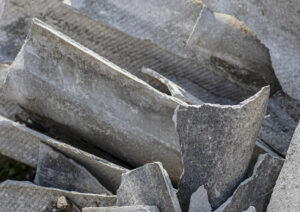Mesothelioma / Asbestos / How to Identify Asbestos / What Does Asbestos Smell Like?
What Does Asbestos Smell Like?
The mineral asbestos does not have an odor. As such, you can’t tell if something has asbestos in it just by smelling it. Other odors from asbestos-containing products are often noticeable (like the smell of old carpet). However, testing is the only way to confirm contamination. Trying to “sniff” for the fiber could lead to toxic exposure.
Get Free Mesothelioma Guide
Can You Detect Asbestos by Its Smell?
Asbestos is the name for a category of minerals. Until the 1980s, manufacturers mixed the naturally chemical- and fire-resistant substance into thousands of construction materials and consumer products. Yet, you cannot detect asbestos in these products by smell.
Today, the risk of toxic exposure comes from friable asbestos materials. Often, humans can’t see friable or “loose” dust from asbestos-containing material (ACM) because the fibers are so small. Moreover, the dust does not have an odor.
In most cases, the only way to tell if something has asbestos is through testing by a laboratory. Also, sometimes products like consumer sheet gaskets, fireproof blankets, wicks held warning labels like “asbestos-containing.”
Unfortunately, construction tradespeople and home renovators won’t know they’re around asbestos by smell either. Asbestos insulation, roofing, and floor tiles, for instance, don’t release odors from the toxin. Moreover, any smell caused by these ACMs is typically caused by other ingredients in the products.
Abatement Project Odors
In construction zones, people sometimes notice a strange odor during abatement projects and try to identify it. However, this is not the smell of asbestos in the air. Normally, removal of ACM includes wetting materials to prevent the risk of airborne fibers. As a result, building materials like wet carpet, insulation, old roofing, and deteriorating pipes may give off an unpleasant odor. Additionally, some remediation companies use chemical solvents to remove asbestos tape and adhesives.
To prevent exposure to asbestos, testing, and removal should be carried out by certified professionals. Look to your state’s department of public health for approved asbestos handlers in your area.
Smelling Asbestos and Cancer Risk
Though asbestos doesn’t smell, trying to sniff asbestos-containing products and materials is potentially hazardous to your health. Over time, ACMs become damaged or worn down. Subsequently, the asbestos mixed into materials is exposed to the air. Often, the fibers are too small to see without a microscope. Also, their weightlessness lets them stay afloat for days.
Smelling broken floor tiles or popcorn ceilings for asbestos contamination puts you at risk of inhaling the fibers. Additionally, people working or living nearby are at risk of breathing in asbestos dust.
After inhaling or sniffing asbestos, the body tries to get rid of toxins through the mucus. Yet, some of the tiny fibers pass through to become lodged in cells lining the lungs, abdomen, or heart. The carcinogen changes the DNA in these cells. Years after trying to smell asbestos, you could develop symptoms of cancer.
Asbestos-related Cancers
Ultimately, following hazardous exposure, your risk of asbestos-related cancers increases. Depending on the amount of exposure, it takes up to 40 years to show early signs of disease. Asbestos poisoning symptoms include:
- Dry cough lasting at least 2 months
- Feeling tired often
- Swollen fingertips
- Trouble taking a full breath
- Wheezing when you breathe deeply
Usually, a diagnosis depends on several examinations and tests. Primarily, asbestos exposure is linked to rare cancers like mesothelioma. Other asbestos-related diseases include:
- Asbestosis
- Colorectal cancer
- Larynx cancer
- Lung cancer
- Ovarian cancer
- Pharynx cancer
- Pleural effusions
- Pleural plaques
- Stomach cancer
After a Diagnosis
For many families, it’s a hectic time after being diagnosed with an asbestos-related cancer (like peritoneal mesothelioma). To manage treatment costs and lost wages, reach out to a mesothelioma attorney.
Qualified lawyers guide clients through legal claims knowing that time is an essential factor.
Mesothelioma Support Team
Mesothelioma Hub is dedicated to helping you find information, support, and advice. Reach out any time!
